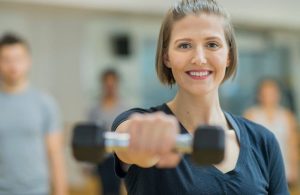People with fibromyalgia may get even greater health benefits from exercise than other people. Regular exercise can help reduce fatigue and raise your energy level. Fibromyalgia is a chronic condition that causes widespread pain, cognitive dysfunction, and fatigue. Exercise is a common recommendation, and research supports both aerobic and strength training to reduce symptoms.
Yet, when you have fibromyalgia, exercising may be the last thing you feel like doing. People suffering from chronic pain struggle to get through their regular daily activities. Adding exercise may seem like an insurmountable task. It’s natural to be concerned that exercise may make your pain worse or leave you completely fatigued.
Interestingly, research shows that exercise can decrease the pain of fibromyalgia, improve sleep, and give you more energy. The fibromyalgia pain treatment specialists at AllCare Health & Pain understand the physical and emotional burden caused by chronic pain. Our specialists are trained in pain management and routinely use gentle and consistent exercise to help manage pain in certain conditions.
When you start an exercise program, it’s important to start slowly. It’s much easier to add activity in small doses every day. Building up your activity level slowly over time can help reduce your pain and keep you from getting discouraged.
For example, if you walk for ten minutes each day, try increasing it by ten percent each week. If you use this formula, you will walk 11 minutes each day in the second week. Choose the exercises you use with care. Don’t place too much strain on your body and look for low-impact aerobic and strength training exercises to help reduce pain and improve function.
The following five exercises work well for patients with fibromyalgia who are looking for active and functional ways of reducing their pain.
Walking

Walking is an excellent low-impact aerobic activity that can help control fatigue and pain. Begin by walking as little as five minutes each day. It is an excellent exercise since you can do it anywhere and all you need is a good pair of shoes. A good goal to work toward is 30 minutes of aerobic activity three times per week.
Yoga

Yoga is a blend of stretches and meditation that can help you get fit and reduce your fibromyalgia pain. It is one of the most recommended forms of exercise for people with fibromyalgia. It’s a gentle way to loosen tight muscles and joints and focus your mind on the present. The exercise is low impact and helps to realign your joints, so your body is supported properly.
Strength Training

Strength training is excellent for people with or without fibromyalgia. It helps to lower your pain, reduce depression, and works your joints through a range of motion. Strength training improves the muscles that support your large weight-bearing joints.
It’s helpful to get tips from a trainer at a fitness center before you start. Hand-held weights or elastic bands work well at home. One study showed that strength training reduces pain, fatigue, depression, anxiety, and the number of tender points while increasing functional capacity.
Pool Exercises

Warm water and light exercise are perfect ways of easing pain for people with fibromyalgia. Research showed pool exercises may be easier and better than aerobics in the gym or a home-based strength and stretching program. The water offers both buoyancy to reduce weight bearing on your joints and gentle resistance to improve muscle strengthening. This reduces stiffness and muscle spasms and increases flexibility. You also don’t need to be a lap swimmer. Gently walking against the water’s resistance provides ample movement for your muscles and joints.
Stretching

You don’t have to break out in a sweat to enjoy the benefits of exercise. In fact, gentle stretching can help improve your pain and discomfort from fibromyalgia by loosening tight muscles and improving your range of motion. Stretching also helps maintain better posture, which can help reduce pain in your upper and lower back, shoulders, hips, and knees.
Be careful not to overdo stretches. They are best done after some light aerobic work that has warmed up your muscles. Remember to move gently and never stretch to the point of pain. You can get the maximum benefit by holding a light stretch for up to a minute.
Contact AllCare Health & Pain for Help with Your Fibromyalgia
The Jersey City pain management specialists of AllCare Health & Pain consistently work with patients who have difficulty with chronic pain associated with fibromyalgia. We understand the challenges you face to include exercise in your daily routine. Our specialists are here to help you design an effective and efficient exercise program to meet your needs and reduce your pain. Call the office at 201-386-9800 today to make your first appointment.

